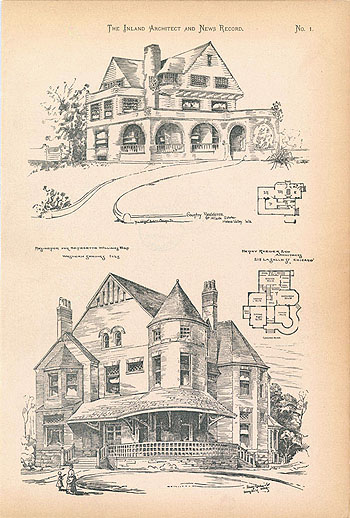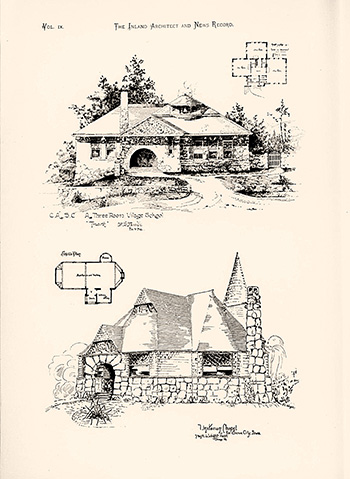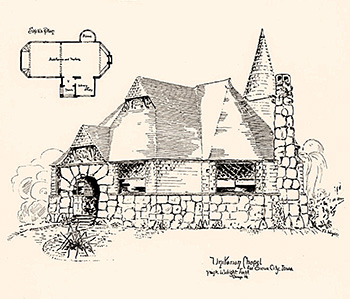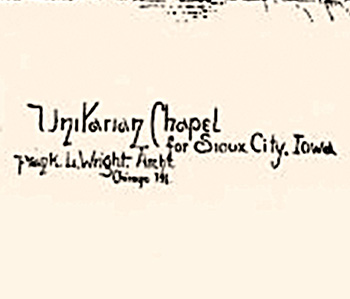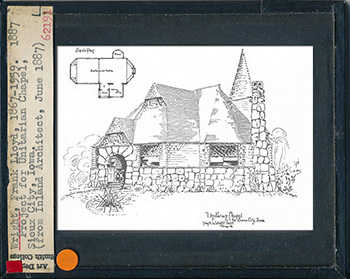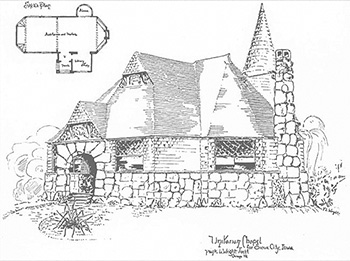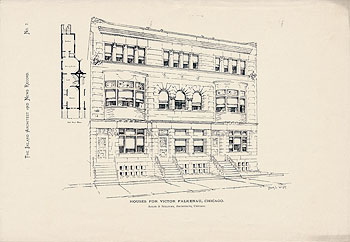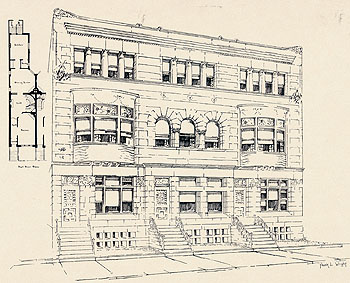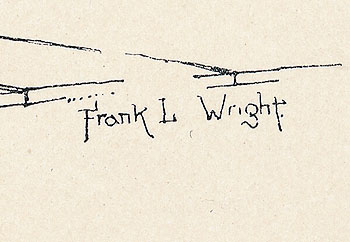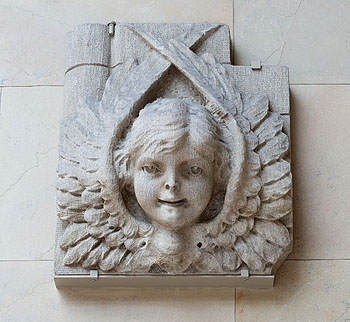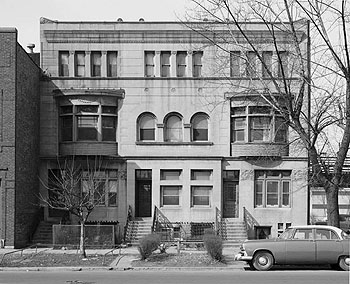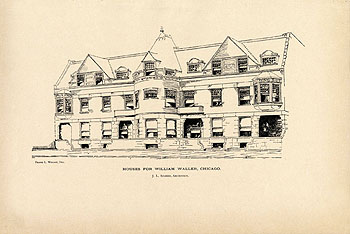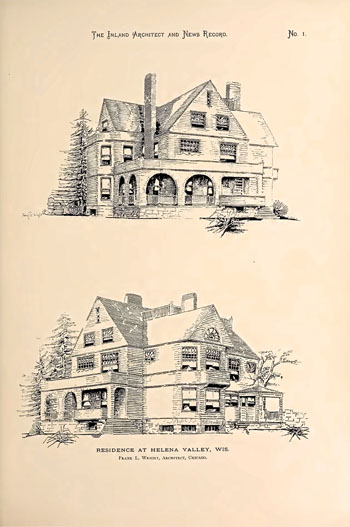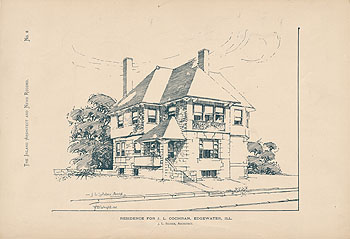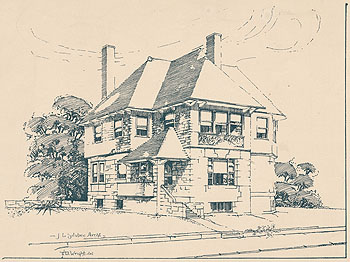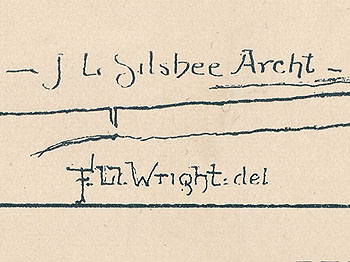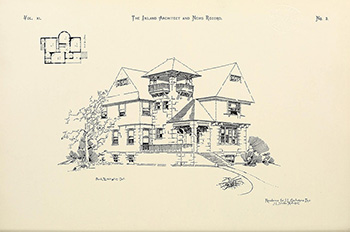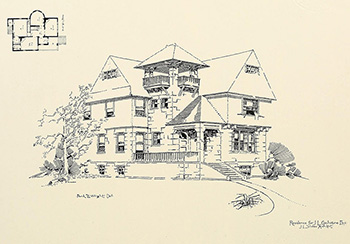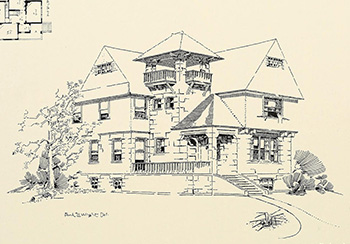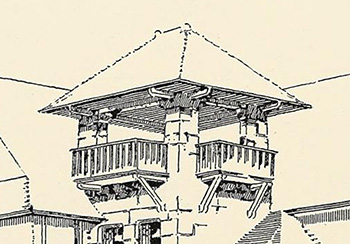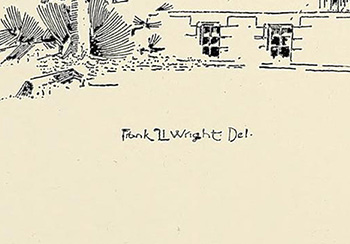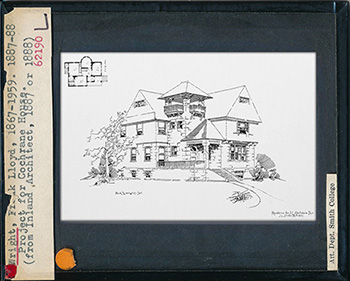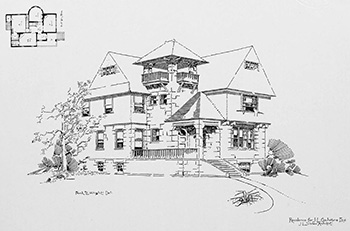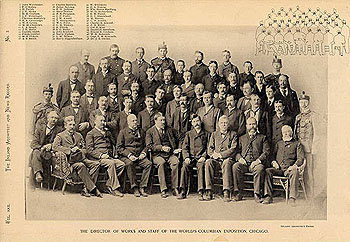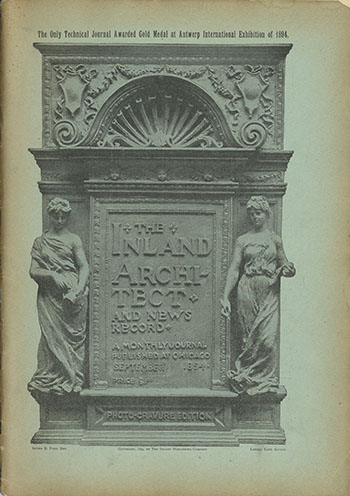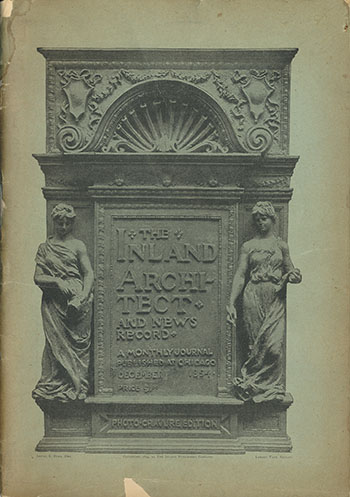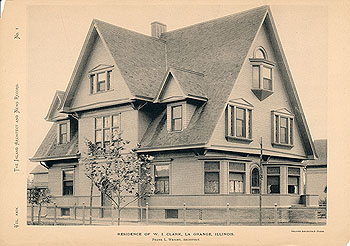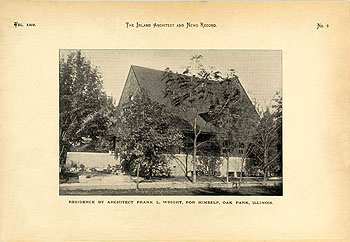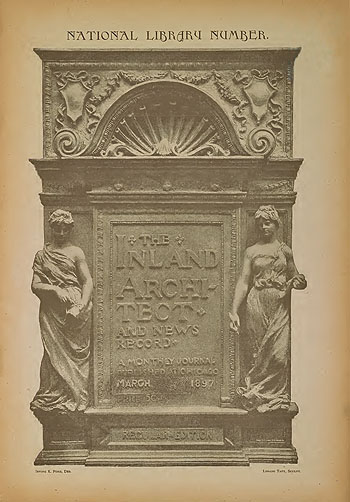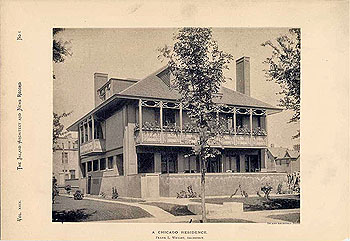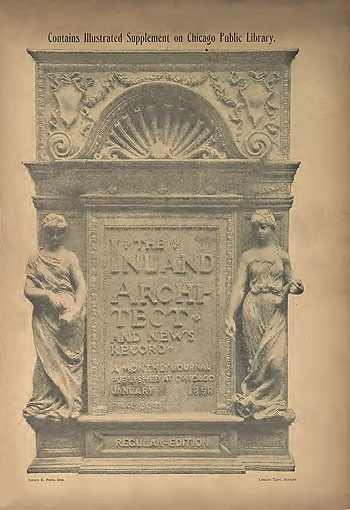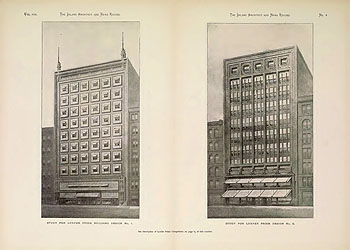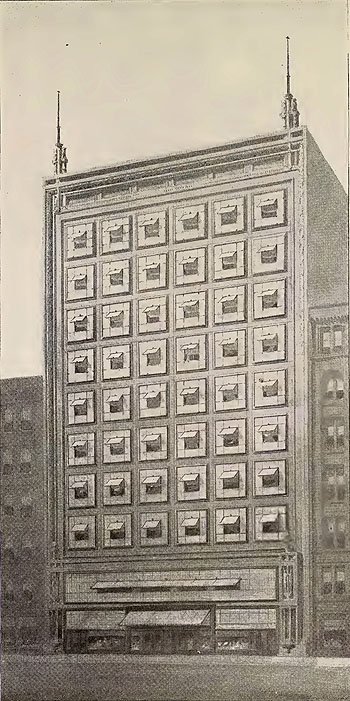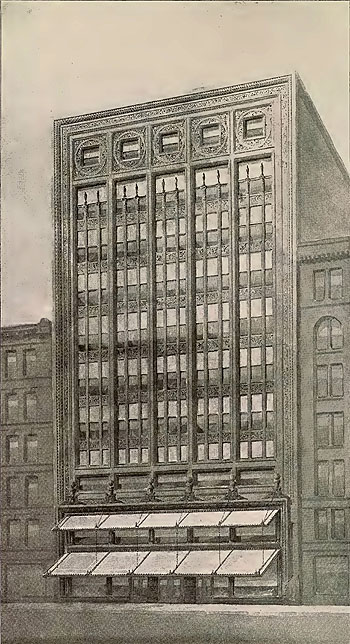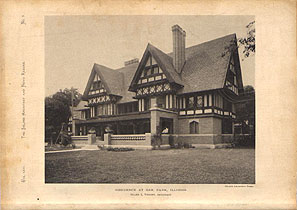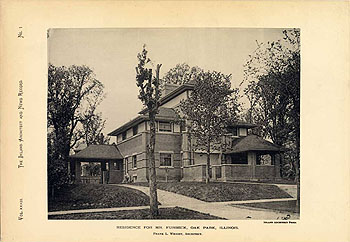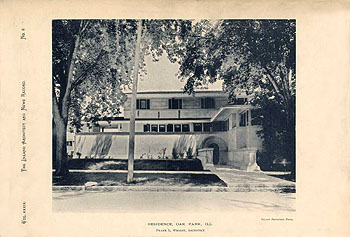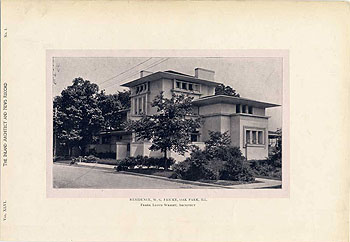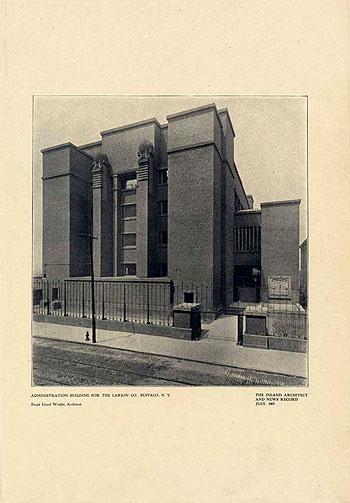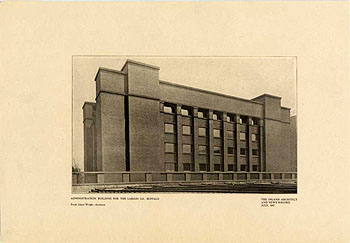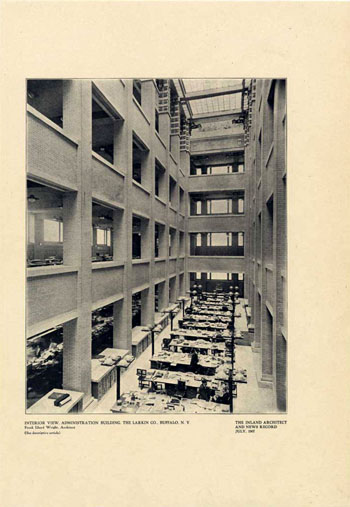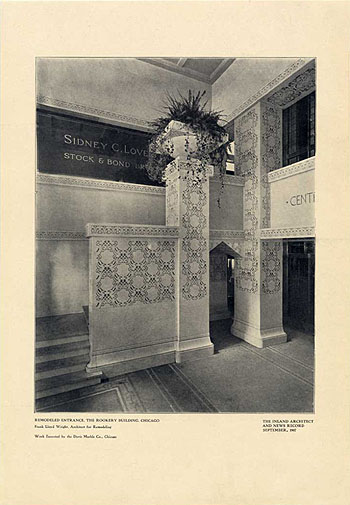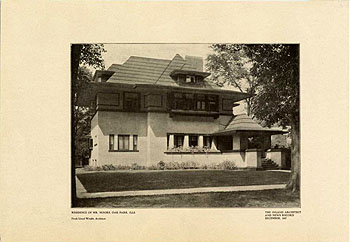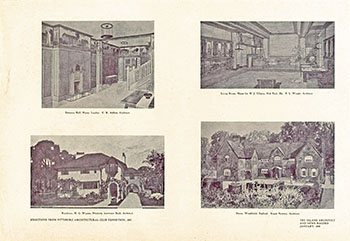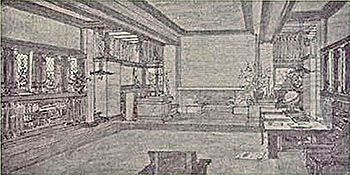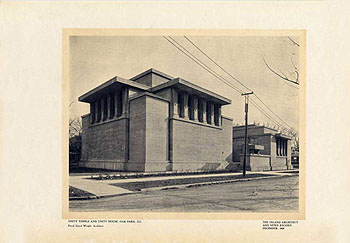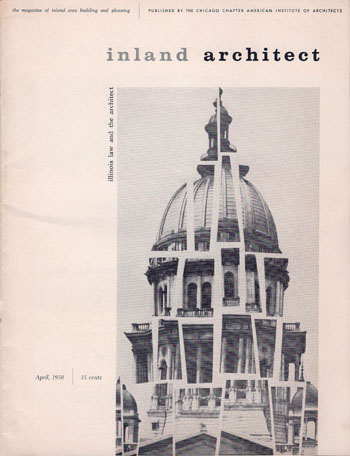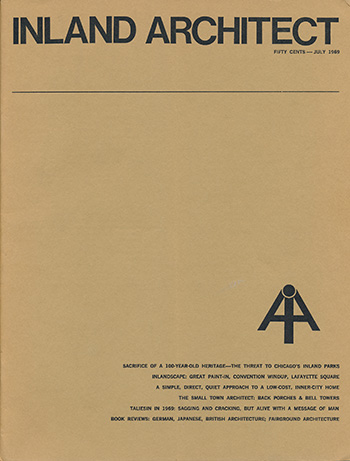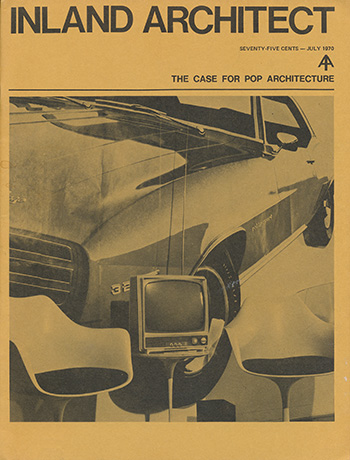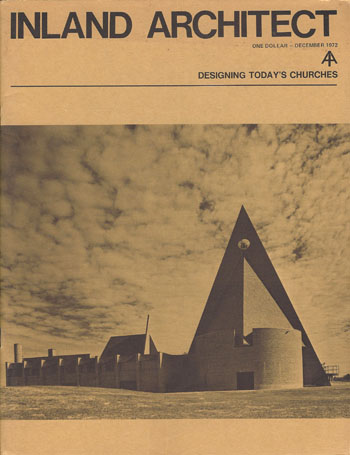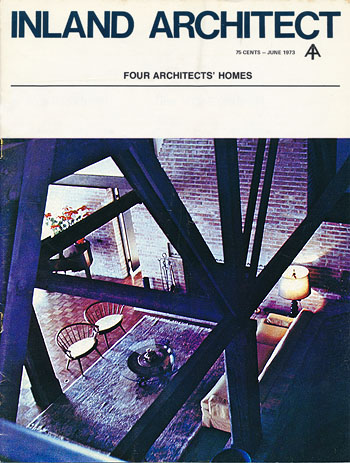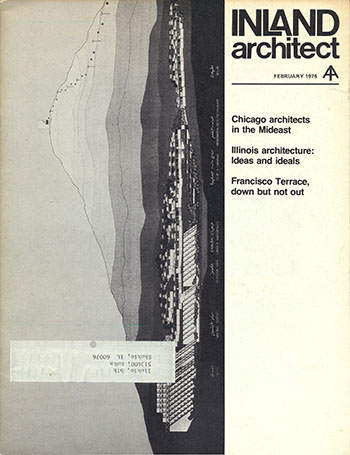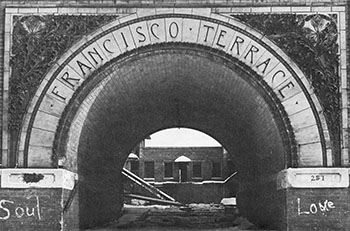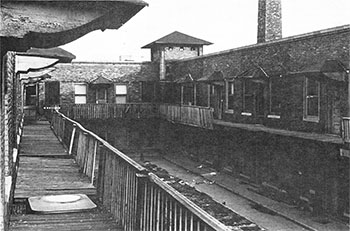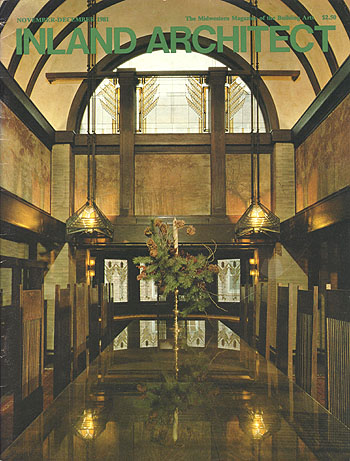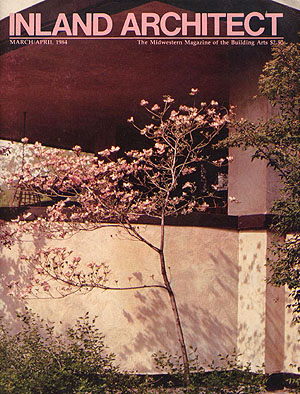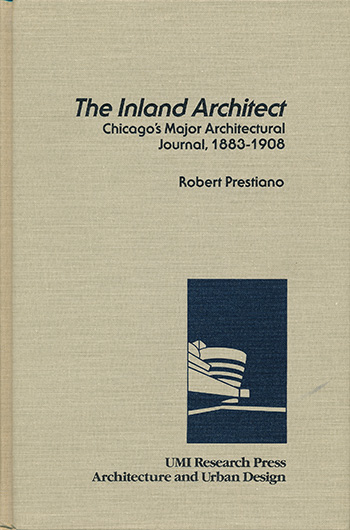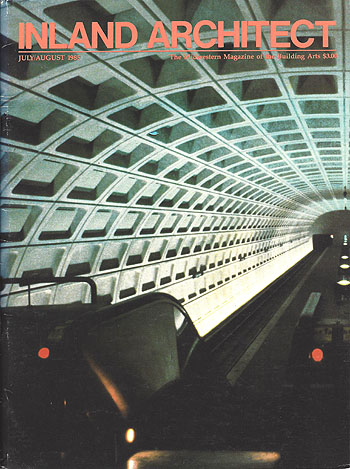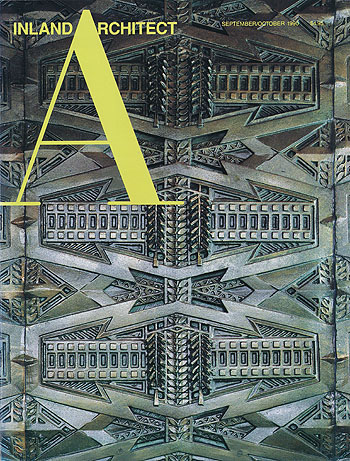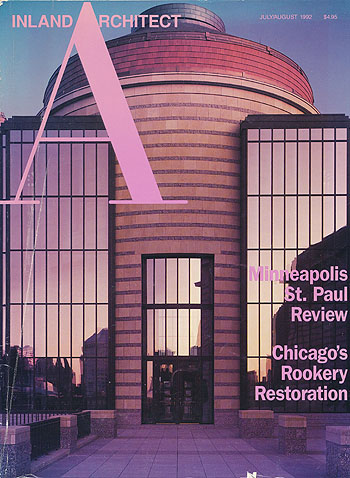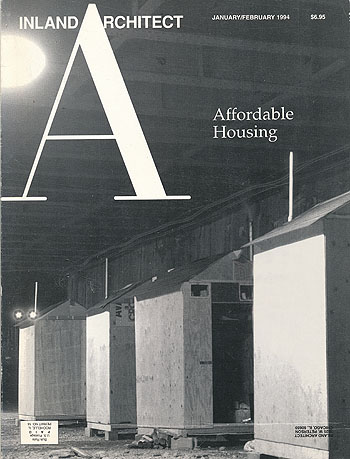
SUPPORT THE
WRIGHT LIBRARY
PROCEEDS FROM EVERY SALE GOES TO SUPPORT THE WRIGHT LIBRARY.
CLICK TO ORDER.
WE PROUDLY SUPPORT THE FRANK LLOYD WRIGHT FOUNDATION
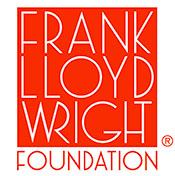
WE PROUDLY SUPPORT THE FRANK LLOYD WRIGHT BUILDING CONSERVANCY
WE PROUDLY SUPPORT FALLINGWATER
AND THE WESTERN PENNSYLVANIA CONSERVANCY

INLAND ARCHITECT & NEWS RECORD
Date: 1887
Title: The Inland Architect & News Record - Volume X, No.1 - August 1887 (Published by the Inland Architect & News Record)
Author: Wright, Frank Lloyd
Description: Hillside Home School (FLLW #8703). (Upper illustration.) Text: "Country Residence for Hillside Estate - Helena Valley, Wis." Signed: "F. L. Wright, Arch. - Chicago, Ill." Perspective drawing and plan for the Hillside Home School. At the time, the area around Taliesin was known as Helena Valley. This is possible s alight variation of the final design. Ellen (Nell) and Jane Lloyd Jones, Frank Lloyd Wright's aunts, formed the Hillside Home School in 1887 and ran it until 1915 when it closed. The private school accepted students between the ages of seven and seventeen. It espoused non-conventional teaching methods, and was the first coeducational school in the nation. After attending the University of Wisconsin, Madison, Wright headed for Chicago in 1887 and accepted a position as draftsman in the architectural firm of Joseph Lyman Silsbee. That year, his Aunts drafted him to design a school building for them, a large shingle styled building, reflected the designs of his mentor Silsbee, and in the style of his first project, Unity Chapel, in Spring Green. (Sweeney 2)
Size: 10 x 7 Color Photograph.
Pages: Plate 1
S#: 0002.00.1021Date: 1887
Title: The Inland Architect & News Record - Volume IX, No.8 - June 1887 (Published by the Inland Architect & News Record)
Author: Wright, Frank Lloyd
Description: Perspective illustration of the Unitarian Chapel for Sioux City, Iowa. (FLLW #8702 - Project). (Lower illustration.) Text: “Unitarian Chapel for Sioux City, Iowa.” Signed: “Frank L. Wright, Arch. - Chicago, Ill.” Published in Frank Lloyd Wright to 1910, Manson, 1958, p.17.
Bruce Brooks Pfeiffer wrote, “The Unitarian Chapel was Wright's first independent commission and, although unbuilt, the drawing was published in Inland Architect in 1887...” Frank Lloyd Wright, Complete Works 1885-1916, 2011. (Sweeney 3)
Size: 10 x 7 Color photograph.
Pages: Plate 1
S#: 0003.00.0825
Perspective illustration of the Unitarian Chapel for Sioux City, Iowa. Text: “Unitarian Chapel for Sioux City, Iowa.” Signed: “Frank L. Wright, Arch. - Chicago, Ill.”Date: 1887
Title: Unitarian Chapel for Sioux City, Iowa. 1887 (FLLW #8702 - Project).
Description: Vintage 4" x 3.25" Magic Lantern Slide of the Unitarian Chapel for Sioux City, Iowa. Copy slide of the perspective illustration by Frank Lloyd Wright, published in the Inland Architect & News Record, June 1887 (Sweeney 3. Magic lantern slides were used in the U.S. during the late 1800s through the first half of the 1900s. Text: “Unitarian Chapel for Sioux City, Iowa.” Signed: “Frank L. Wright, Arch. - Chicago, Ill.”
Bruce Brooks Pfeiffer wrote, “The Unitarian Chapel was Wright's first independent commission and, although unbuilt, the drawing was published in Inland Architect in 1887...” Frank Lloyd Wright, Complete Works 1885-1916, 2011.
Text on face of slide: “Wright, Frank Lloyd, 1867-1959. 1887. Project for Unitarian Chapel, Sioux City, Iowa. (From Inland Architect, June 1887). 62191. Art Dept Smith College.” Acquired from the Art Department at Smith College.
Size: Magic lantern slide 4" x 3.25", Transparency: 3" x 2.25"
S#: 0003.01.0725
DetailDate: 1888
Title: The Inland Architect & News Record - V. XI No.7 - June 1888 (Published by The Inland Architect Press)
Author: Signed Frank L. Wright
Description: Illustration by Frank Lloyd Wright. "Houses for Victor Falkenau, Chicago. Adler & Sullivan, Architects, Chicago." Signed: "Frank L. Wright." In 1887 Frank Lloyd Wright joined the firm of Adler & Sullivan where he worked for six years. A description was published in "The Daily Inter Ocean," December 16, 1888: "The Material Of The Fronts Is Blue Bedford Stone, With Pressed Brick For The Other Walls. There Are Elegant Copper Bays At The Second Storey And Much Beautiful Carving In Stone, Especially About The Cornice And In The Open Lattice-Work Of The Basement. Two Cherub Heads Are Introduced Very Effectively. The Houses Are Three-Storey And Basement, With Hardwood Finish Throughout The First Floor, Very Elaborate Gas-Fixtures, And The Most Liberal Provision Of Sanitary Appliances. The Sidewalks Are Stone, And So Are The Steps Of The House, And The Latter Are Protected By Wrought Iron Rails. The Houses Have Electric Annunciators, Furnaces, Cemented Basement Floors, And Especially Handsome Mantels. The Parlor Floor And The Chambers Up Stairs Are Admirably Arranged, All Space, Even The Nooks, Being Utilized By A Cunning Hand." While employed by Adler & Sullivan he also designed the Sullivan Bungalow and Stables (1890 - S.006), the Charnley Bungalow (1890 - S.007), Guesthouse and Stables (1890 - S.008), Charnley Residence (1891 - S.009) and the Albert Sullivan Residence (1892 - S.019). The three row-houses were located at 3420-24 South Wabash avenue, Chicago. They were demolished in 1958. (Sweeney 5)
Size: 13.5 x 9.25
Pages: Plate 7
S#: 0005.00.0819
Signed: "Frank L. Wright"Date: 1888
Title: Victor Falkenau Row House Element, Chicago, 1888. Adler & Sullivan, Architects, Chicago.
Description: Terra-cotta Cherub, designed for the face of the three houses in 1888, salvaged from the Victor Falkenau Row Houses during demolition. In 1887 Frank Lloyd Wright joined the firm of Adler & Sullivan where he worked for six years. An illustration of the Falkenau Row Houses was published in the Inland Architect & News Record - V. XI No.7 - June 1888. "Houses for Victor Falkenau, Chicago. Adler & Sullivan, Architects, Chicago." Signed: "Frank L. Wright." A description was published in "The Daily Inter Ocean," December 16, 1888: "The Material Of The Fronts Is Blue Bedford Stone, With Pressed Brick For The Other Walls. There Are Elegant Copper Bays At The Second Storey And Much Beautiful Carving In Stone, Especially About The Cornice And In The Open Lattice-Work Of The Basement. Two Cherub Heads Are Introduced Very Effectively. The Houses Are Three-Storey And Basement, With Hardwood Finish Throughout The First Floor, Very Elaborate Gas-Fixtures, And The Most Liberal Provision Of Sanitary Appliances" The Sidewalks Are Stone, And So Are The Steps Of The House, And The Latter Are Protected By Wrought Iron Rails..." The three row-houses were located at 3420-24 South Wabash avenue, Chicago. They were demolished in 1958. Salvaged by Richard Nickel, They All Fall Down, Cahan, 1994, p.80-81. Courtesy of The Art Institute of Chicago. 31 ˝ x 35 ˝ x 18."
Size: 10 x 8 Color photograph.
S#: 0005.01.0919Date: Circa 1950
Title: Victor Falkenau Row House, Chicago, Circa 1950.
Description: Adler & Sullivan, Architects, Chicago. Photographed by Richard Nickels. In 1887 Frank Lloyd Wright joined the firm of Adler & Sullivan where he worked for six years. An illustration of the Falkenau Row Houses was published in the Inland Architect & News Record - V. XI No.7 - June 1888. "Houses for Victor Falkenau, Chicago. Adler & Sullivan, Architects, Chicago." Signed: "Frank L. Wright." A description was published in "The Daily Inter Ocean," December 16, 1888: "The Material Of The Fronts Is Blue Bedford Stone, With Pressed Brick For The Other Walls. There Are Elegant Copper Bays At The Second Storey And Much Beautiful Carving In Stone, Especially About The Cornice And In The Open Lattice-Work Of The Basement. Two Cherub Heads Are Introduced Very Effectively. The Houses Are Three-Storey And Basement, With Hardwood Finish Throughout The First Floor, Very Elaborate Gas-Fixtures, And The Most Liberal Provision Of Sanitary Appliances. The Sidewalks Are Stone, And So Are The Steps Of The House, And The Latter Are Protected By Wrought Iron Rails..." The three row-houses were located at 3420-24 South Wabash avenue, Chicago. Photographed by Richard Nickel. They All Fall Down, Cahan, 1994, p.80-81. Courtesy of The Art Institute of Chicago.
Size: 10 x 8 B&W photograph.
S#: 0831.77.0919Date: 1888
Title: The Inland Architect & News Record - V. XI - May 1888 (Published by The Inland Architect Press)
Author: Signed F. Ll. Wright: Del.
Description: "Residence For William Waller, Chicago. J. L. Silsbee, Architect." Signed: "F. Ll. Wright: Del." After attending the University of Wisconsin, Frank Lloyd Wright headed for Chicago. In 1887 he took a position as draftsman for Joseph Lyman Silsbee, an architect well known for Queen Anne and Shingle-Style homes. Later that year, he moved to the office of Alder and Sullivan. Wright wrote about his experience working with Joseph Lyman Silsbee. "Silsbee was doing Edgewater at the time, the latest attempt at high-class subdivision, and doing it entirely for J. L. Cochran, a real-estate "genius" in his line... His work was a picturesque combination of gable, turret and hip, with broad porches quietly domestic and gracefully picturesque... The office system was a bad one. Silsbee got a ground-plan and made his pretty sketch, getting some charming picturesque effect he had in his mind. Then the sketch would come out into the draughting room to be fixed up into a building, keeping the floor-plan near the sketch if possible. But the sketches fascinated us. 'My God, Cecil, how that man can draw!" An Autobiography, Wright, 1932, p.70. Silsbee must have been impressed with Wright's ability to illustrate, giving him credit for this illustration, published in 1888. (Sweeney #6)
Size: 10 x 6.5 Color photograph.
Pages: Pp 1
S#: 0006.00.0521Date: 1888
Title: The Inland Architect & News Record - Volume XI, No 1 - February 1888 (Published by the Inland Architect & News Record)
Author: Wright, Frank Lloyd
Description: Hillside Home School (FLLW #8703). Two perspective drawings. Text: "Residence At Helena Valley, Wis. Frank L. Wright, Architect, Chicago." Signed: "Frank L. Wright" Two perspective drawing for the Hillside Home School. At the time, the area around Taliesin was known as Helena Valley. Ellen (Nell) and Jane Lloyd Jones, Frank Lloyd Wright's aunts, formed the Hillside Home School in 1887 and ran it until 1915 when it closed. The private school accepted students between the ages of seven and seventeen. It espoused non-conventional teaching methods, and was the first coeducational school in the nation. After attending the University of Wisconsin, Madison, Wright headed for Chicago in 1887 and accepted a position as draftsman in the architectural firm of Joseph Lyman Silsbee. That year, his Aunts drafted him to design a school building for them, a large shingle styled building, reflected the designs of his mentor Silsbee, and in the style of his first project, Unity Chapel, in Spring Green. (Sweeney 7)
Size: 10 x 7 Color Photograph.
Pages: Plate 1
S#: 0007.00.1021Date: 1888
Title: The Inland Architect & News Record - V. XI No.8 - July 1888 (Published by The Inland Architect Press)
Author: Signed F. Ll. Wright: del.
Description: "Residence For J. L. Cochran, Edgewater, ILL. J. L. Silsbee, Architect." Signed: "F. Ll. Wright: del." After attending the University of Wisconsin, Frank Lloyd Wright headed for Chicago. In 1887 he took a position as draftsman for Joseph Lyman Silsbee, an architect well known for Queen Anne and Shingle-Style homes. Later that year, he moved to the office of Alder and Sullivan. Wright wrote about his experience working with Joseph Lyman Silsbee. "Silsbee was doing Edgewater at the time, the latest attempt at high-class subdivision, and doing it entirely for J. L. Cochran, a real-estate "genius" in his line... His work was a picturesque combination of gable, turret and hip, with broad porches quietly domestic and gracefully picturesque... The office system was a bad one. Silsbee got a ground-plan and made his pretty sketch, getting some charming picturesque effect he had in his mind. Then the sketch would come out into the draughting room to be fixed up into a building, keeping the floor-plan near the sketch if possible. But the sketches fascinated us. 'My God, Cecil, how that man can draw!" An Autobiography, Wright, 1932, p.70. Silsbee must have been impressed with Wright's ability to illustrate, giving him credit for this illustration, published in 1888. (Sweeney 8)
Size: 13.5 x 9.25
Pages: Plate 8
S#: 0008.00.0819
Left: Detail.
Right: Signed "F. Ll. Wright: del."Date: 1888
Title: The Inland Architect & News Record - Volume XI, No.3 - March 1888 (Published by the Inland Architect & News Record)
Author: Signed F. Ll. Wright: Del.
Description: Perspective illustration of the Residence for J. L. Cochrane (Cochran). Text: “Residence for J. L. Cochrane, Esq. J. L. Silsbee, Architect.” Signed: “Frank Ll. Wright Del.”
After attending the University of Wisconsin, Frank Lloyd Wright headed for Chicago. In 1887 he took a position as draftsman for Joseph Lyman Silsbee, an architect well known for Queen Anne and Shingle-Style homes. Later that year, he moved to the office of Alder and Sullivan. Wright wrote about his experience working with Joseph Lyman Silsbee. "Silsbee was doing Edgewater at the time, the latest attempt at high-class subdivision, and doing it entirely for J. L. Cochran, a real-estate “genius” in his line... His work was a picturesque combination of gable, turret and hip, with broad porches quietly domestic and gracefully picturesque... The office system was a bad one. Silsbee got a ground-plan and made his pretty sketch, getting some charming picturesque effect he had in his mind. Then the sketch would come out into the draughting room to be fixed up into a building, keeping the floor-plan near the sketch if possible. But the sketches fascinated us. 'My God, Cecil, how that man can draw! " An Autobiography Wright, 1932, p.70. Silsbee must have been impressed with Wright’s ability to illustrate, giving him credit for this illustration, published in 1888. Published in Frank Lloyd Wright to 1910, Manson, 1958, p.16. (Sweeney 9)
Size: 10 x 6.5 Color photograph.
Pages: Plate 1
S#: 0009.00.0825Date: 1888
Title: Perspective illustration of the Residence for J. L. Cochrane 1888.
Description: Vintage 4" x 3.25" Magic Lantern Slide of the Residence for J. L. Cochrane. Copy slide of the perspective illustration by Frank Lloyd Wright, published in the Inland Architect & News Record, March 1888 (Sweeney 9). Magic lantern slides were used in the U.S. during the late 1800s through the first half of the 1900s. Text: “Residence for J. L. Cochrane, Esq. J. L. Silsbee, Architect.” Signed: “Frank L. Wright.”
Text on face of slide: “Wright, Frank Lloyd, 1867-1959. 1887-88. Project for Cochrane House. (From Inland Architect, 1887 or 1888). 62190. Art Dept Smith College.” Acquired from the Art Department at Smith College.
Size: Magic lantern slide 4" x 3.25", Transparency: 3" x 2"
S#: 0009.13.0725Date: 1893
Title: William Storrs MacHarg (McHarg), Chicago, Illinois, 1893 (1891 - S.10).
Description: World's Columbian Exposition Senior Management Staff. Published in The Inland Architect and News Record, (1893) Volume XXII, No. 5. Wm. Storrs MacHarg is #35, Second row, fifth from the right. Daniel Hudson Burnham is #44, First Row, fifth from the right. Frank Lloyd Wright designed the MacHarg Residence in 1891 while working for Louis Sullivan. MacHarg was the Chief Engineer in Chicago for water, sewage and fire-protection, and oversaw much of the related construction in Chicago. He was also part of the management team for the Chicago World's Columbian Exposition in 1893. Text: "The Director of Works and Staff of the World's Columbian Exposition, Chicago." Courtesy of the Art Institute of Chicago.
Size: 10.5 x 7.25 B&W B&W photograph.
S#: 0013.18.0620Date: 1894
Title: Inland Architect & News Record - V. XXIV No.2 September, 1894 (Published by the Inland Architect Press, Chicago)
Author: Anonymous
Description: Announcement of a drawing competition for the Chicago Architectural Sketch Club. Frank Lloyd Wright was a member of the Adjudicating Committee.
“Competition, Robert Clark Testimonial.
The competition is open to architectural draftsman under 30 years of age, residence of the United States, and not practicing architects. The author of each design must execute all drawings without assistance, and nonadherence to these conditions will cause the rejection of the design or designs in question.
The awards will be made by the Adjudicating Committee on the " Robert Clark Testimonial" competition, and are: First prize, gold medal; second prize, silver medal; third prize, bronze medal.
Those designs receiving honorable mention will receive special bronze medals.
The prize drawings are to become the property of the Chicago Architectural Sketch Club.
Programme.
A design for the façade of an "Art Club " house in a Classic or Renaissance style, the building to be situated on a residence boulevard.
The building shall be eighty feet in width, situated on a lot one hundred feet in width and at a distance of twenty-five feet from the inside line of the sidewalk. The lot is not situated on a
corner, and little or no attention is to be paid to the sides of the building, beyond indicating the proper return of the cornice, etc., in the perspective.
The rooms which require expression and which take their light from this front are:
First Story - An entrance located in the center and a single room on either side, to be used as reception and reading rooms...
W. B. Mundie, Chairman,
Frank L. Wright,
Irving K. Pond,
Adjudicating Committee on the " Robert Clark Testimonial."
Original cover price $1.00. 9.75 x 13.75. (Sweeney 15)
Size: 9.75 x 13.75
Pages: Pp 17
S#: 0015.00.0723Date: 1894
Title: Inland Architect & News Record - V. XXIV No.5 December, 1894 (Published by the Inland Architect Press, Chicago)
Author: Anonymous
Description: A letter announcing the winners of the Robert Clark Testimonial. (See S.15). Signed by Frank Lloyd Wright and others on the Adjudicating Committee.
Chicago Architectural Sketch Club. November 30, 1894.
Dear Sir, I submit herewith the report of the Adjudicating Committee for the Robert Clark Testimonial, which I trust you will give prominence in your publication.
The jury appointed to award the medals for the Robert Clark Competition submit the following:
"The competition as a whole was a decided success. The draftsmanship excellent, with but few exceptions. Considering the age limit of thirty years, the same cannot be said of the main feature in the competition, that is, that a building should look like, and suggest what it is intended for. The great majority of contestants submitted designs too suggestive of art galleries, institutes, etc., too monumental in their arrangement of parts, and the disposition of detail too lavish.
"The selections were finally narrowed down to four designs and the awards were made by a written vote of each judge.
"For Gold Medal, Willard Hirsh, Cleveland, Ohio.
"For Silver Medal, Edwin R. Clark, Lowell, Massachusetts.
" For Bronze Medal, Ernest F. Guilbert, Chicago, Illinois.
Mention, Albert Kahn, Detroit, Michigan.
*W. B. Mundie, Chairman.
"Frank L. Wright.
"Irving K. Pond."
Sixty-five designs were submitted, aggregating one hundred and thirty drawings of an unusually high order of merit.
The drawings will be exhibited next month at the Art Institute, and immediately thereafter be returned to their owners.
Please accept the thanks of the Chicago Architectural Sketch Club for your interest in the competition. I am, very truly yours,
John Robert Dillon, Secretary.
Original cover price $1.00. 9.75 x 13.75. (Sweeney 14)
Size: 9.75 x 13.75
Pages: Pp 48
S#: 0014.00.0723Date: 1894 Publication: Inland Architect & News Record - Vol. XXIV No.1 (August 1894) (Published by the Inland Architect Press)
Author: Anonymous
Description: "Residence of W. I. Clark, La Grange, Illinois. Frank L. Wright, Architect." W. Irving Clark Residence (S.013 - 1893). In 1887 Wright joined the firm of Adler & Sullivan. To earn extra income Wright designed "bootleg" houses while still working for Adler & Sullivan. The W. Irving Clark house was one of Wright's first bootleg homes, commissioned in 1892 and completed in 1893. A dispute grew out of his acceptance of independent commissions, and in 1893 Sullivan fired Wright. Wright began his own firm, and this example of Wright's work was published in August, 1894. Photogravure only, no text, Hors-texte Plate, printed single side only. (Sweeney 16)
Size: 13.3 x 9.1
Pages: Pp 1
S#: 0016.00.0811
Date: 1895
Title: Inland Architect & News Record - Volume XXIV No.6, August 1895 (Published by the Inland Architect Press)
Author: Anonymous
Description: "Residence By Architect Frank L. Wright, For Himself, Oak Park, Illinois. View of Frank Lloyd Wright's home from the South, on Chicago Avenue. Wright designed his home in 1889, added the Playroom, Dining Room and Kitchen in 1895, and his Studio in 1897. (Sweeney 17)
Size: 10 x 8 color photographic copy.
Pages: Pp 1
S#: 0017.00.0519Date: 1897
Title: Inland Architect & News Record - March, 1897, V. XXIX #2 (Digital Edition) (Published monthly by The Inland Publishing Co., Chicago, Ill.)
Author: Anonymous
Description: Architectural Possibilities of the Luxfer Prism. That the architectural methods of today will not he in vogue in future is as clear to the thinking mind as that the methods of a generation ago have been displaced by those of the present age. The world moves, and despite our boasted advancement we shall be left far behind in a few years if we do not keep pace with the procession. No one who now visits New York City, for instance, after an absence of five or six years, can fail to notice the vast improvement in the planning of the downtown district. Steel and terra cotta and glass have fairly revolutionized the old methods of stone and brick and darkness. The high building is as truly a result of evolution from former ideas as is the lightning express or the ocean steamer... To characterize this new prism as one of the most remarkable improvements of the century in its bearing on practical architecture is to speak but mildly. In the opinion of some of the foremost architects of this country the Luxfer prism is destined to work an entire revolution in planning, and to necessitate very extensive changes in construction. In view of the practical unanimity of the highest authorities on this point, a careful consideration of some of the reasons for their belief will be of interest... This will no longer be necessary, since the Luxfer prism gathers up the precious rays and deposits them in the remotest corner, wherever they may be wanted. And while its use may diminish the electric light and gas bills, the benefit to health and comfort will be incalculable.
Size: 11 x 15.5
Pages: Pp 18
S#: 0026.01.0720Date: 1897
Title: Dr. Allison W. Harlan House, Chicago, Illinois, View 1897 (1892 - S.018).
Author: Anonymous
Description: View of the Harlan House from the Southeast. Published in The Inland Architect and News Record, July, 1897, Volume XXIX, No. 6. Text: "A Chicago Residence. Frank L. Wright, Architect." Designed in 1892 while Frank Lloyd Wright still worked for Louis Sullivan, it is considered one of Wright's "bootlegged" houses. There are two cantilevered balconies, one that runs the length of the front of the house, and a shorter balcony on the South elevation. The face, side and possibly the base of the balcony is covered in Sullivanesque panels, and the front balcony is topped with planters. Just below the roof line is another simplified cut-out design, which is repeated in the dormer above. The entrance is reached on the left side of the house. Stairs lead up to a hall that is open on the second floor. The Library is straight ahead, Living Room to the right, Dining and Kitchen to the left. Five sets of floor to ceiling doors (and or windows) in the Living Room open to an enclosed Terrace. A side entrance is seen on the left. Over time, the front balcony was modified, and the side balcony eliminated, exposing the large semi-circular window in the stairwell. (Sweeney 23)
Size: 8 x 10 color photograph.
Pages: Pp 1
S#: 0023.00.0420Date: 1898
Title: Inland Architect & News Record - March, 1898, V. XXX #6 (Digital Edition) (Published monthly by The Inland Publishing Co., Chicago, Ill.)
Author: Anonymous
Description: An Interesting Competition. The American Luxfer Prism Company have organized a competition among architects and draftsmen that presents many interesting features. The remarkable lighting effects obtained by their method of prismatic radiation has established an innovation similar to the advent of the elevator in changing the designs of buildings and in increasing their available space. Now architects are called upon to show in a competition in which liberal premiums are paid, how the prismatic light can be further utilized, and also united with architectural effects... Includes Wright's illustration for the Luxfer Building. (Sweeney 30)
Size: 11 x 15.5
Pages: Pp 63-64, Plate 11 A&B
S#: 0030.00.0720Date: 1898
Title: Inland Architect & News Record - March, 1898, V. XXX #6 - Plate 11 A&B (Published monthly by The Inland Publishing Co., Chicago, Ill.)
Author: Anonymous
Description: Two Studies for the Luxfer Prism Building. Dietrich Neumann wrote: No architect's name was given for either design, but "design no. 1" was later republished by Wright as his own. "Design no. 2," similar in character and overall layout, was drawn by the same draftsman. This design, too, was in all probability created by Wright." Journal of the Society of Architectural Historians, March 1995, p.30. Wright later published Design 1 in the Architectural Forum, January 1938, and in A Testament, 1957. Text on plate: "Study for Luxfer Prism Building Design No. 1. Study for Luxfer Prism Design No. 2. See description of Luxfer Prism Corporation on page 63 of this number." (Sweeney 30)
Size: Double Plate: 22 x 15.5. 10.5 x 7.5 Color photograph.
Pages: Plate 11 A&B
ST#: 0030.01.0720
Description on Page 64:
"Study for Luxfer Prism Building -- Design No. 1. This suggestion is based upon a story height of eleven feet, and a divisional unit of eleven feet in plan. No attempt at structural elaboration has been made, but the steel frame quietly and consistently covered with terra cotta. The openings are simply covered with rich screens of Luxfer iridian prisms set in slightly projecting frames of ornamental iron. In general surface and effect these are similar to the forilux installed in the second story of the Home Insurance building, of Chicago, the offices of Armour & Co., and the Union National Bank. Openings with movable iron frames for ventilation and filled with plate glass are introduced in the middle of this richly bordered surface of prisms." The wall surfaces are preserved and enriched by this treatment, as the Luxfer iridian plates are as solid and substantial in appearance as the wall itself. The openings in the center of the plate which are here shown, about four feet square, are protected by a light canopy filled with prisms which permits a view of the street, and further increases the light. The structural members in the first and second stories are screened by the prism surfaces which are carried in front of them. The plate glass is retained in the lower part of the first story for show window purposes, and for the same reason a plate glass center is inserted in the second story forilux, also covered by a canopy.
Description on Page 64:
Study for Luxfer Prism Building -- Design No. 2. This suggestion is in the nature of an emphasis of the vertical members of the steel frame, knit together at the top and at the bottom. The usual attempt at florid " topping out " has been dispensed with, and a simple rich frame of terra cotta completes the structure within itself. The upper portion of each bay is filled with a surface of Luxfer iridian prisms. The lower portion, which is shaded dark, is filled with plate glass. This treatment provides a continuous frieze of Luxfer prisms in the upper part of each story. The first and second stories are provided with canopies swung from the top of ornate posts or columns beginning at the second floor level. These columns also carry electric lights. The entire surface of the first and second story fronts, underneath the canopies, is of plate glass, showing the structural members behind.Date: 1898 Publication: The Inland Architect And News Record - Vol. XXXI, No.5 (Published by the Inland Architect Press)
Author: Anonymous
Description: "Residence at Oak Park, Illinois. Frank L. Wright, Architect." Photograph of the original 1895 home before the fire that destroyed it in 1922. It was reconstructed in 1923 by Wright. IA&NR had a very small circulation at the time and these prints only appeared in a very limited number of issues that were distributed to a few prominent architects. Photogravure only, Hors-texte Plate. (Sweeney 32)
Size: 12.75 x 9
Pages: Pp 1
S#: 0032.00.0606
Date: 1899
Title: Inland Architect and News Record - Volume XXXIII No. 1 1899 (Published by The Inland Architect & News Record)
Author:
Description: Street View Rollin Furbeck Residence. "Residence For Mr. Furbeck, Oak Park, Illinois. Frank L. Wright, Architect." This is one of the earliest photographs of the Furbeck Residences and captures Wright's original intent. The Porte Cochere is on the left, with the driveway leading in from the street. By the 1940s the Porte Cochere had been enclosed, and the driveway removed. The entrance was reached through low exposed walls that were removed by the 1940s. The transition from Wright's earlier homes with Sullivanesque details, toward his Prairie style is evident. The facade of the upper two floors in the front is similar to the Winslow (1894), Heller 1896) and Husser (1899). But it also has the beginnings of his prairie style with the horizontal bands from the upper sills to the soffits. Of particular note is the use of wood trim within the upper horizontal bands. This became a design element in Wright's later Prairie styled homes. This is possibly the first home to utilize this design element. Photogravure only, no text, Hors-texte Plate, printed single side only. (Copy) Courtesy of The Art Institute of Chicago, Ryerson & Burnham Archives. (Sweeney 36)
Size: 7 x 10
Pages: Pp 1
S#: 0036.00.1016Date: 1902
Title: Inland Architect and News Record - Volume XXXIX No. 6 1902 (Published by The Inland Architect & News Record)
Author: Anonymous
Description: Street View Frank Wright Thomas Residence. "Residence Oak Park, Illinois. Frank L. Wright, Architect." It is considered to be the first fully developed prairie styled house in Oak Park. It is also the first house in Oak Park to be completely designed in Stucco. Upon entering the front door, stairs lead up to the main living quarters on the second level. The bedrooms on the third floor. Some of the design features included beaded molding and exquisite leaded glass windows. Photogravure only, no text, Hors-texte Plate, printed single side only. Courtesy of The Art Institute of Chicago, Ryerson & Burnham Archives. (Sweeney 52)
Size: 7 x 10 Photographic copy.
Pages: Pp 1
S#: 0052.00.1016Date: 1905
Title: Inland Architect and News Record - Volume XLVI No. 1 1905 (August 1905) (Published by The Inland Architect & News Record)
Description: Street View William G. Fricke Residence From the Southwest. "Residence, W. G. Fricke, Oak Park, ILL. Frank L. Wright, Architect." Like the Thomas Residence, also 1901 and in Oak Park, it is an all-stucco exterior. But unlike the Thomas Residence which is considered Frank Lloyd Wright's first fully developed prairie styled house in Oak Park, it includes elements of Wright's transitional designs like the Rollin Furbeck Residence: Corners turned at a 45 degree angle; Massive central tower; Rectangular square windows with columns; More vertical than Wright's prairie styled horizontal designs. It is also a three story home. The Living and Dining Rooms, Kitchen, Hall and Reception Room are on the first level. The Bedrooms are on the second level. Photogravure only, no text, Hors-texte Plate, printed single side only. Courtesy of The Art Institute of Chicago, Ryerson & Burnham Archives. (Sweeney 56)
Size: 7 x 10 Photographic copy.
Pages: Pp 1
S#: 0056.00.1116Date: 1907 Title: Inland Architect & News Record, Volume L (50), July 1907 (Published by The Inland Architect & News Record)
Author: Anonymous
Description: Front View. "Administration Building for the Larkin Co., Buffalo, N. Y. Frank Lloyd Wright, Architect." Photogravure only, no text, Hors-texte Plate, printed single side only. Courtesy of The Art Institute of Chicago, Ryerson & Burnham Archives. (Sweeney 71)
Size: 7 x 10 (Copy)
Pages: Pp 1
S#: 0071.00.05171 A
Date: 1907 Title: Inland Architect & News Record, Volume L (50), July 1907 (Published by The Inland Architect & News Record)
Author: Anonymous
Description: View of the east side. "Administration Building for the Larkin Co., Buffalo, N. Y. Frank Lloyd Wright, Architect." Photogravure only, no text, Hors-texte Plate, printed single side only. Courtesy of The Art Institute of Chicago, Ryerson & Burnham Archives. (Sweeney 71)
Size: 7 x 10 (Copy)
Pages: Pp 1
S#: 0071.00.05171 B
Date: 1907 Title: Inland Architect & News Record, Volume L (50), July 1907 (Published by The Inland Architect & News Record)
Author: Anonymous
Description: "Interior View, Administration Building for the Larkin Co., Buffalo, N. Y. Frank Lloyd Wright, Architect. (See descriptive article.)" Photogravure, Hors-texte Plate, printed single side only. Courtesy of The Art Institute of Chicago, Ryerson & Burnham Archives. (Sweeney 71)
Size: 7 x 10 (Copy)
Pages: Pp 1
S#: 0071.00.05171 C
Date: 1907 Publication: Inland Architect & News Record, Volume L (50), September 1907 (Published by The Inland Architect & News Record)
Author: Anonymous
Description: "Remodeled Entrance. The Rookery Building. Chicago. Frank Lloyd Wright, Architect for Remodel. Work Executed by the Davis Marble Co., Chicago." Photogravure only, no text, Hors-texte Plate, printed single side only. (Copy) Courtesy of The Art Institute of Chicago, Ryerson & Burnham Archives. (Sweeney 75)
Size: 7 x 10.25 (Copy)
Pages: Pp 1
S#: 0075.00.0512
Date: 1907 Publication: Inland Architect & News Record, Volume L (50), December 1907 (Published by The Inland Architect & News Record)
Author: Anonymous
Description: "Residence of Mr. Moore, Oak Park, Ill. Frank Lloyd Wright, Architect." This is actually the Mary and Edward R. Hills Remodeling (1900, 1906 - S.051). Mary Hills was Nathan G. Moore's daughter. He hired Wright to remodel the home as a wedding gift for his daughter. Photogravure only, no text, Hors-texte Plate, printed single side only. Courtesy of The Art Institute of Chicago, Ryerson & Burnham Archives. (Sweeney 77)
Size: (Copy) 7 x 10
Pages: Pp 1
S#: 0077.00.0512
Date: 1908
Title: Inland Architect & News Record - Volume LI (51), January 1908 (Published by The Inland Architect & News Record)
Author: Anonymous
Description: “Selections From Pittsburgh Architectural Club Exhibition, 1907. The Inland Architect And News Record, January, 1908. Top Right: Living Room, House for H. J. Ullman, Oak Park, Illinois. F. L. Wright Architect.” Photogravure only, no text, Hors-texte Plate, printed single side only. Courtesy of The Art Institute of Chicago, Ryerson & Burnham Archives. (Sweeney 81)
Size: 10 x 8 Color photograph.
Pages: Pp 1
S#: 0081.00.0823
H. J. Ullman, Oak Park, Illinois. F. L. Wright Architect.Date: 1908 Title: Inland Architect & News Record - Volume LII December 1908 (Published by The Inland Architect & News Record)
Author: Anonymous
Description: "Unity Temple and Unity House, Oak Park, Ill. Frank Lloyd Wright, Architect." Photogravure only, no text, Hors-texte Plate, printed single side only. (Copy) Courtesy of The Art Institute of Chicago, Ryerson & Burnham Archives. (Sweeney 84)
Size: 7 x 10.
Pages: Pp 1
S#: 0084.00.0914
Date: 1958 Title: Inland Architect - April 1958, Chicago Chapter, American Institute of Architects (Published monthly except July and August by the Chicago Chapter of the American Institute of Architects, Chicago)
Author: 1) Moderator: Cook, Alister; Wright, Frank Lloyd
2) AnonymousDescription: 1) "Forum of Formidable: Discussed by key figures in the building and business worlds, and held as part of the Chicago Dynamic Program at the Museum of Science and Industry in Chicago, October 30, 1957." Moderator: Alister Cook. Participates included Ira Bach, commissioner of planning, Chicago, leading business men and Frank Lloyd Wright. Includes photograph of participants, among them Wright.
2) "Art: the work of Alfonso Iannelli. The work of sculpture Alfonso Iannelli will be on exhibit during may at the offices of the Chicago Chapter A.I.A., continuing the series of monthly exhibitions of artists" work arranged by the Chicago Chapter artists Equity." Includes a brief biographical sketch including his work with Wright for the Midway Gardens. Includes one photograph.
Original cover price 35 cents.Size: 8.5 x 11
Pages: 1) Pp 14-17
2) Pp 6-7S#: 1259.21.0511
Date: 1969
Title: Inland Architect - July 1969 (Published monthly by Inland Architect Corp., Chicago, Illinois. Affiliated with the Illinois Council and Chicago Chapter, American Institute of Architects.)
Author: Marlin, William
Description: Taliesin 1969: Sagging and Cracking, But Alive With A Message of Man.
Frank Lloyd Wright has been gone 10 years, buried close to his roots by Hillside Chapel. In this 102d year since his birth, we are rethinking his massive contributions to architecture and American life. What better place for stocktaking than Taliesin, his legendary "House of the North" in Spring Green, Wisconsin?
Cantilevers are sagging, the roof leaks, shingles rot, the plaster is cracking and falling. But Taliesin comes more alive with the years, soon to be fixed by a new generation of apprentices. With national or state recognition, it could be officially what it was unofficially during Wright's life, a kind of U.N. in the Wisconsin hills—a center for the exchange of ideas and information on the human condition.
For Wright believed profoundly that architects should help to express new concepts of social policy and regional development...
Includes four photographs of Taliesin, Spring Green, one photograph of the Spring Green Restaurant, and one illustration of the Spring Green Ski Lodge (Taliesin Architects). Original cover price 50c. (Sweeney 1786)
Size: 8.5 x 11
Pages: Pp 22-25
S#: 1786.00.0925Date: 1970
Title: Inland Architect - July 1970 (Published monthly by Inland Architect Corp., Chicago, Illinois. Affiliated with the Illinois Council and Chicago Chapter, American Institute of Architects.)
Author: Anonymous
Description: Design for Dining. (Spring Green Restaurant). Frank Lloyd Wright had strong opinions about many things, including the proper way to dine. "Most of the well-known restaurants architecturally are Parisian," he once noted. "The French restaurant is the hallmark of French character."
Wright, of course, put some of these principles into the design of his own Spring Green restaurant in Spring Green, Wis. (Inland Architect, July 1969). Its stone and glass are banked into a hill with Wright's special ease. No flashing neon of the Chicago-Las Vegas sort mars the river road entrance. Instead, there is a Wrightian sign that glows quietly at night. The design is repeated on menus and napkins.
The pleasant Yesteryear restaurant in Kankakee, Ill. occupies one of Wright's best Prairie houses (Bradley House), and another Wright house on Chicago's Sheridan Rd. used to be the setting for a French restaurant-until the wrecker came along (Steffens House).
But this quality of architecture is rare in restaurants, and certainly so in Chicago. There are Chicago dining places of charm and distinction, of course, but many of the most ambitious offer one or another version Includes four photographs of Taliesin, Spring Green, one photograph of the Spring Green Restaurant, and one illustration of the Spring Green Ski Lodge (Taliesin Architects). Original cover price 75c. (Sweeney 1819)
Size: 8.5 x 11
Pages: Pp 16-17
S#: 1819.00.0925Date: 1972
Title: Inland Architect - December 1972 (Published monthly by the Inland Architect Corporation, Chicago)
Author: Bowly, Devereux, Jr.
Description: Unity Temple, A Masterpiece on the Way to Restoration. Frank Lloyd Wright once said: "Unity Temple, Robie House and the Imperial Hotel, these are what I had to say." The Imperial Hotel, sadly, has gone; the Robie House happily has been saved, although it no longer is used for its original purpose; Unity Temple not only survives but is still a working church - one with the growing membership. Indeed, Wright's early concrete monolith, a block and a half from the rattling "L" in Oak Park, stands today as the best remaining example of his public buildings. And, unlike the Imperial, Midway Gardens and the Larkin Building, to take three examples of distraction, it apparently is on its way to preservation... Includes three photographs, one which includes Lloyd Wright (son). Original cover price $1.00. (Sweeney 1888)
Size: 8.5 x 11 (
Pages: Pp 18-19
S#: 1888.00.0519Date: 1973
Title: Inland Architect - June 1973 (Published monthly by the Bruce Publishing Company, Minneapolis, Minn)
Author: Miller, Nory
Description: "Four architects with their own design for living." One of the four homes includes the Mrs. Thomas Gale Residence. "Howard Rosenwinkel's home is the realization of a boyhood dream. A partner in the firm of... he was inspired to study architecture by Frank Lloyd Wright's Oak Park houses, and now he owns one - the Mrs. Thomas Gale of 1909. He and his wife Nancy bought it in 1963 from Sally Gale, daughter of the original owner. It was stuffed with Victorian furniture; the front balcony had fallen onto the lawn; and surfaces were encrusted from years of non-maintenance. Neighbor had even circulated a petition to demolish the eyesore. But the young couple worked hard, with limited funds, to restore a loved it object and have been repaid manifold. "When you actually live here," says Rosenwinkel, "you notice the small touches of Wright's genius - how the simple technique of adding two steps makes the dining room is sitting place, how the flat plane of the fireplace keeps the heat from driving you to the edge of the room..." Includes three photographs of the Gale Residence. (Sweeney 1933)
Size: 8.5 x 11
Pages: Pp 8-13
S#: 1933.00.0719Date: 1976
Title: Inland Architect - February 1976 (A publication of Inland Architect Corporation, Published monthly by the Craftsman Press, Minneapolis, Minn)
Author: Bowly, Devereux, Jr.
Description: "Saving the idea of Wright's 1895 'model tenement." On Chicago's slum-beset Near West Side is located one of the increasing number of vacant lots in the inner city. Until early in 1974 it had a building which was a classic in the history of low-income housing, Francisco Terrace. If this country had learned the lessons it could have taught us, we might have stayed away from high-rise public housing, and all the problems it has created.
Francisco Terrace was a 44-unit "model tenement" designed by Frank Lloyd Wright in 1895, when he was 28. The developer was Edward Waller, a businessman of means and vision. Waller lived across the street from the famous Winslow House (1893) that Wright designed in River Forest, and was a friend of Wright. In 1905 Wright remodeled the lobby of the Rookery Building for Waller, who was the manager.
The most important aspect of Francisco Terrace was its plan. The building filled the perimeter of its rectangular lot at 253 N. Francisco, with a large courtyard in the center. It was two stories high, with a tunnel cut through to connect the street to the courtyard.
The front doors of the apartments opened. onto the courtyard, and the four corners contained semi-enclosed stair towers for access to the wooden gallery that the second floor apartments opened onto.
By eliminating hallways, and having each apartment open directly to the courtyard, Wright created the feeling of a small village built around a square. This arrangement was..." Includes three photographs of the original building, and two illustrations of the planned reconstruction. (Sweeney 2008)
Size: 8.5 x 11
Pages: Pp 18-20
S#: 2008.00.0623Date: 1982
Title: Inland Architecture - November/December 1982 (Published 10 times a year by Inland Architect Press, Chicago, IL)
Author: O'keefe, Daniel R.
Description: Inlandscape: "Grand entrances. ...were what the colorful mining heiress Susan Lawrence Dana liked to make, and them she did in the vast, vista-filled house that a 32-year-old Oak Parker named Frank Lloyd Wright designed for her down in Springfield, Illinois. Commissioned in 1899 and opened with a Christmastime party for the workers who built it in 1904, the Dana house became a showplace where many a governor was entertained..." Includes five photographs. Original cover price $2.50. Gift from Kathryn Smith.
Size: 8.75 x 11.5
Pages: Pp Cover, 30-31
ST#: 1982.141.0616Date: March/April 1984 Publication: Inland Architect (Published by Inland Architect Press, Chicago)
Author: 1) Morgan, Maya 2) Birkey, Randal 3) Stubbs, John H. 4) Anonymous
Description: 1) "In the Garden with Frank Lloyd Wright". The lasting impressions of Wright influenced one Wright house inhabitant to generate a profusion of garden flowers and plants. Tomek House, Riverside, Illinois. Original List Price $2.50.
2) Ad: "Randal Birkley Architectural Delineation". Uses Plate 40, Hardy House perspective, Wasmuth Portfolio. Original List Price $2.50.
3) Ad: "Rare Books & Prints". Uses cover of 1934 Taliesin Publication "Taliesin, Volume 1, No 1". Original List Price $2.50.
4) Events: Milwaukee Art Museum thru May 13. Illustrations for Architecture: Wright's Wasmuth Portfolio. Includes one illustration. Original List Price $2.50.Size: 8.75 x 11.5
Pages: 1) Pp Cover 1 26-9 2) Pp 52 3) Pp 52 4) Pp 52, 55
ST#: 1) 1984.22.0305 2) 1984.23.0305 3) 1984.24.0305 4) 1984.25.0305
Date: 1985
Title: The Inland Architect, Chicago’s Major Architectural Journal 1883-1908 (Hard Cover) (Published by UMI Research Press, Ann Arbor, Michigan)
Author: Prestiano, Robert
Description: The first major architectural journal of Chicago and the Middle West announced its appearance in February of 1883 with these words:
Unlike many journalistic infants. The Inland Architect and Builder makes its advent unheralded. The idea of its publication, however, was not suddenly conceived nor hastily matured. A careful canvass convinced its projectors that a periodical devoted to the interests of western architects, builders, house decorators and those engaged in kindred arts, would be cordially welcomed and receive substantial support.
During the twenty-six years of its existence, the Inland Architect was as active toward the organization of the architectural profession as it was intellectually informative through its dissemination of theoretical speculation and technological information...
Includes many references to Frank Lloyd Wright and eleven illustrations related to Wright’s work. (First Edition)
Size: 6 x 9.25
Pages: Pp 251
ST#: 1985.91.0825Date: 1985
Title: Inland Architect - J/A 1985 (Published six times a year by Inland Architect Press, Chicago)
Author: Clarke, Jane H.; Weigard, Elizabeth
Description: 1) "A Moving Violation? ...On March 21, 1985, Wright's body was disinterred by a local mortician. Following cremation in Madison, Wisconsin, the famous architect's ashes were removed to Arizona to be placed next to those of his third wife, Olgivanna, who died March 1..."
2) "The Arts At Midway Gardens. The Midway Gardens were to be, Frank Lloyd Wright said, a place of "light, color, music, movement." Briefly they were. Designed by Wright in 1913-14, the indoor-outdoor garden-theater, concert hall, and dining room, built at the southwest corner of Cottage Grove Avenue and 60th Street..." Includes five photographs, two of which are miss identified as Anna Pavlova at Midway Gardens. Original cover price $3.00.
Size: 8.75 x 11.5
Pages: 1) Pp 1 3-4 2) Pp 45-47
ST#: 1985.60.1116Date: 1990
Title: Inland Architect - September/October 1990 (Published six times a year by Inland Architect Press, Chicago)
Author: 1) Marlin, William Author: 2) McFadden, Dennis Description: 1) "Oh Frahnk: Frank Lloyd Wright and Miriam Noel. Frank Lloyd Wright freely admitted that he had remembered to forget many things in telling his life story. Like Freud, who burned his notes and letters at least twice to frustrate his biographers, Wright seemed determined to make his biographers work hard, dig deep, and (just possibly) give up. Yet throughout his voluminous writings, and especially in the thousands of letters he sent and received, there are embedded abundant clues as to where the elusive truth lies." Includes three photographs. Description: 2) "A Wright Restoration. The Dana-Thomas House Reopens. The State of Illinois has made an extraordinary and generous gift to anyone who cares about architecture. In acquiring, painstakingly restoring, and now opening to the public as a State Historical Site, the Dana-Thomas House in Springfield, the state has preserved and made accessible a very important example of Frank Lloyd Wright's unique genius. When completed in 1904, this was a house that raised eyebrows in the state capital. A prime example of Wright's Prairie Style, the Dana-Thomas house didn't look like anything else in own. Then, too, there was the woman who commission Wright to design it - Susan Lawrence Dana, a prominent Springfield socialite..." Includes 15 photographs and illustrations.
Size: 8.75 x 11.53) An Ad for the A. W. Gridley House, Batavia, Illinois. Includes one photograph. P.95. Pages: Pp 24, 26, 70, 73 Pages: Pp Cover, 1, 31-39 ST#: 1990.177.0921 Date: 1992
Title: Inland Architect - July/August 1992 (Published six times a year by Inland Architect Press, Chicago)
Author: Bruegmann, Robert
Description: "The Rookery Renaissance. Preservation's Touchstone. Complete at last, Chicago's restored Rookery Building sets the standard against which all future commercial renovations must be judged..." In depth article on the history of the Rookery Building and includes Frank Lloyd Wright's involvement. Includes 16 photographs and illustrations, eight of which are of the Wright designed lobby. Also includes a number of ads from companies that were involved in the renovation. Original cover price $4.95.
Size: 8.75 x 11.5
Pages: Pp 50-57
ST#: 1992.140.0421Date: 1994
Title: Inland Architect - January/February 1994 (Published six times a year by Real Estate News Corp,., Chicago)
Author: Woodburn, Judith
Description: "Monona Terrace Update. In 1938, a prominent citizen paid Frank Lloyd Wright $1000 to sketch a design for a lakefront Civic Center in Madison, Wisconsin. The plan Wright devised was nothing short of monumental: a huge semicircular building housing city and county offices, courtrooms, jails, and a railroad station, and a civic auditorium was to be constructed at water level, jutting over Lake Monona on enormous peers..." Includes one photograph of the model of the project Wright designed. Original cover price $6.95.
Size: 8.75 x 11.5
Pages: Pp 18-19
ST#: 1994.128.0221BACK TO TOP
HOME ARTIFACTS AUDIO BOOKS PERIODICALS PHOTOS POSTCARDS POSTERS STAMPS STUDIES ASSISTING ABOUT SLIDE SHOW To donate or pass on information, comments or questions:
steinerag@msn.com
©Copyright Douglas M. Steiner, 2001, 2025




